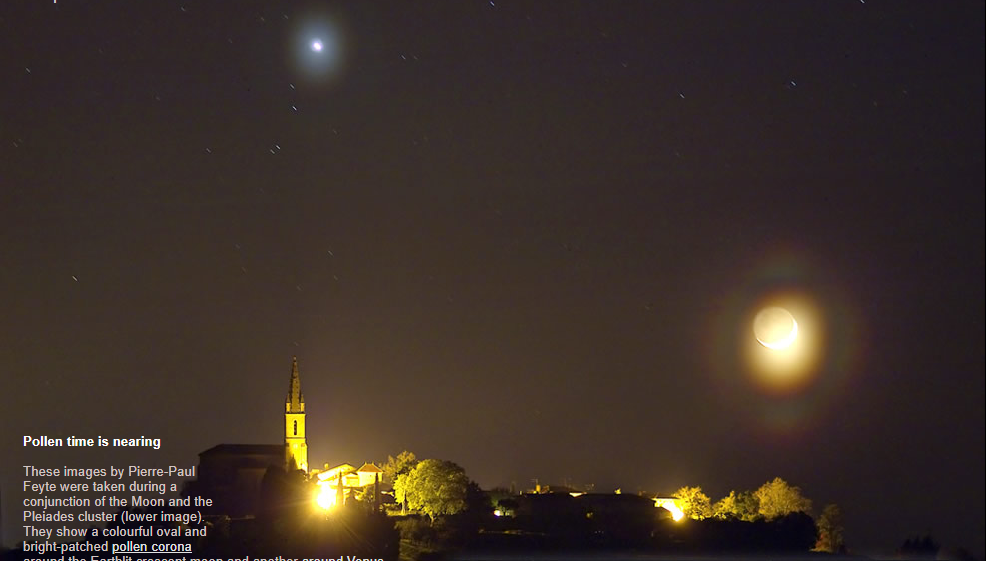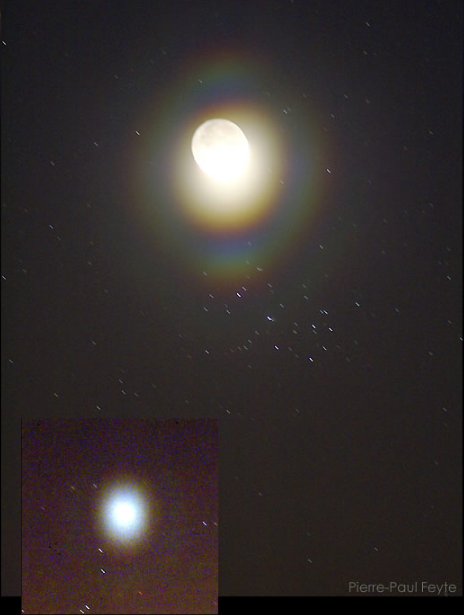Pollen time is nearing
The Arrival of Pollen Season: A Spectacular Display of Atmospheric Optics
As the days grow longer and the weather begins to warm, nature awakens from its winter slumber. One of the telltale signs that spring is on the horizon is the arrival of pollen season. While pollen may be a nuisance for allergy sufferers, it also presents a fascinating opportunity to witness a stunning display of atmospheric optics.
Renowned photographer Pierre-Paul Feyte captured remarkable images during a conjunction of the Moon and the Pleiades cluster. These images showcase a vibrant oval and brightly-patched pollen corona surrounding the Earthlit crescent moon and even Venus. What causes these breathtaking phenomena, and why do they occur during pollen season? Let's delve into the intricacies of this natural spectacle.
The correlation between pollen release and the appearance of pollen coronae is not coincidental. Feyte noticed that the presence of a corona around the moon coincided with the massive cloud of pollen released by the Forêt des Landes, located between his vantage point in South-Western France and the nearby Atlantic Ocean. This expansive forest, spanning 1.5 million square hectares, consists mainly of pine trees, which release billions of monosized pollen seeds.
The key to generating the intricate ringed coronae lies in the uniformity of pollen grain sizes. When light waves encounter particles at the periphery, they scatter and interfere with each other, forming diffraction patterns or coronae around bright light sources. The size of the corona depends on the size of the particles. In the case of pollen, which consists of monosized grains, distinct lunar coronae with multiple rings are formed.
The oval shape of the corona, along with the bright areas on the rings, can be attributed to the non-spherical shape and orientation of pollen grains in the air. These grains possess air sacs that aid in their dispersion by the wind and also serve to orient them. Additionally, the crescent shape of the moon itself contributes to the distortion of the corona's shape, adding further intrigue to the spectacle.
Venus, too, exhibits a corona, albeit much fainter than that of the moon. Capturing the rings around Venus requires long exposures due to the corona's subtle nature. However, with patience and the right equipment, one can witness this ethereal phenomenon.
As the Northern Hemisphere enters pollen season, it's an opportune time to observe pollen coronae. These coronae, smaller than those produced by water droplets in clouds, can be best observed by simply shielding the sun or moon behind the edge of a post or building. By doing so, one can witness nature's artistry and marvel at the intricate patterns formed by these minuscule pollen grains.
In conclusion, the nearing of pollen season brings with it a captivating display of atmospheric optics. The release of monosized pollen grains creates distinctive lunar coronae with multiple rings. The non-spherical shape and orientation of these grains, coupled with the moon's crescent shape, contribute to the corona's unique appearance. While Venus also exhibits a corona, it is considerably fainter. As spring unfolds and nature bursts forth in vibrant colors, take a moment to appreciate the beauty and intricacy of pollen coronae, a testament to the wonders of our natural world.

Pollen time is nearing
These images by Pierre-Paul Feyte were taken during a conjunction of the Moon and the Pleiades cluster (lower image). They show a colourful oval and bright-patched pollen corona around the Earthlit crescent moon and another around Venus. Images ©Pierre-Paul Feyte.

"Two years ago .April 19, 2007 ~20:45UT., as I was taking a few pictures of a moon-Pleiades-Venus conjunction with my village on the foreground, I noticed a corona surrounding the moon. Processed pictures show the same faint - but also coloured - corona.
To me, this is related to the massive cloud of pollen released by the Landes Forest (For�t des Landes) in South-Western France which lies between my location and the Atlantic Ocean 150 kilometres away. The For�t des Landes is one of the biggest artificial forests in the world, and the largest of Western Europe. It's easy to spot the green triangle-shaped 1.5 millions square hectares wood on Google Earth . Now just imagine the billions of pollen seeds released by all those pine trees, all of the same size."
"The same size" - That is the key to generating beautiful ringed coronae. Light waves are scattered at the periphery of particles and interfere to form diffraction patterns - coronae - around bright light sources. The corona size increases as the particle size decreases and so scattering by a cloud of particles of various sizes produces only an aureole without rings. Here the monosized pollen has produced a distinct lunar corona with at least two rings.
The corona is oval with bright areas on the rings because the pollen grains are non-spherical and are specially oriented in the air. They have air sacs to help the wind disperse them widely and the sacs also serve to orient them.
The crescent shaped moon has added its own distortion to the corona shape.
Venus has a similar but much fainter corona and long exposures would be needed to reveal the rings.
Now is the start of the Northern Hemisphere pollen season. Look out for pollen coronae. They are smaller than those from the water droplets of clouds and are best seen by just shielding the sun (or moon) behind the edge of a post or building.
Note: this article has been automatically converted from the old site and may not appear as intended. You can find the original article here.
Reference Atmospheric Optics
If you use any of the definitions, information, or data presented on Atmospheric Optics, please copy the link or reference below to properly credit us as the reference source. Thank you!
-
<a href="https://atoptics.co.uk/blog/pollen-time-is-nearing/">Pollen time is nearing</a>
-
"Pollen time is nearing". Atmospheric Optics. Accessed on November 26, 2024. https://atoptics.co.uk/blog/pollen-time-is-nearing/.
-
"Pollen time is nearing". Atmospheric Optics, https://atoptics.co.uk/blog/pollen-time-is-nearing/. Accessed 26 November, 2024
-
Pollen time is nearing. Atmospheric Optics. Retrieved from https://atoptics.co.uk/blog/pollen-time-is-nearing/.